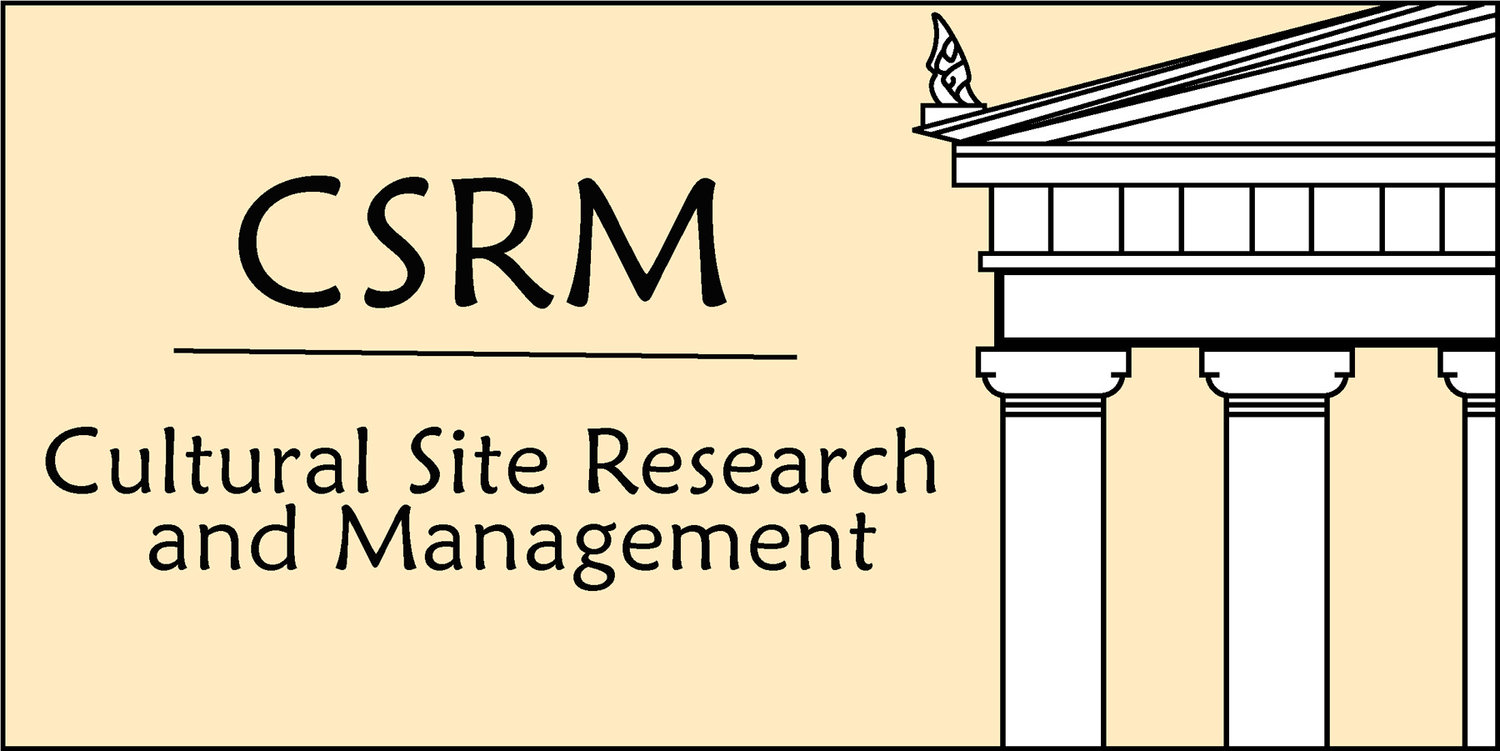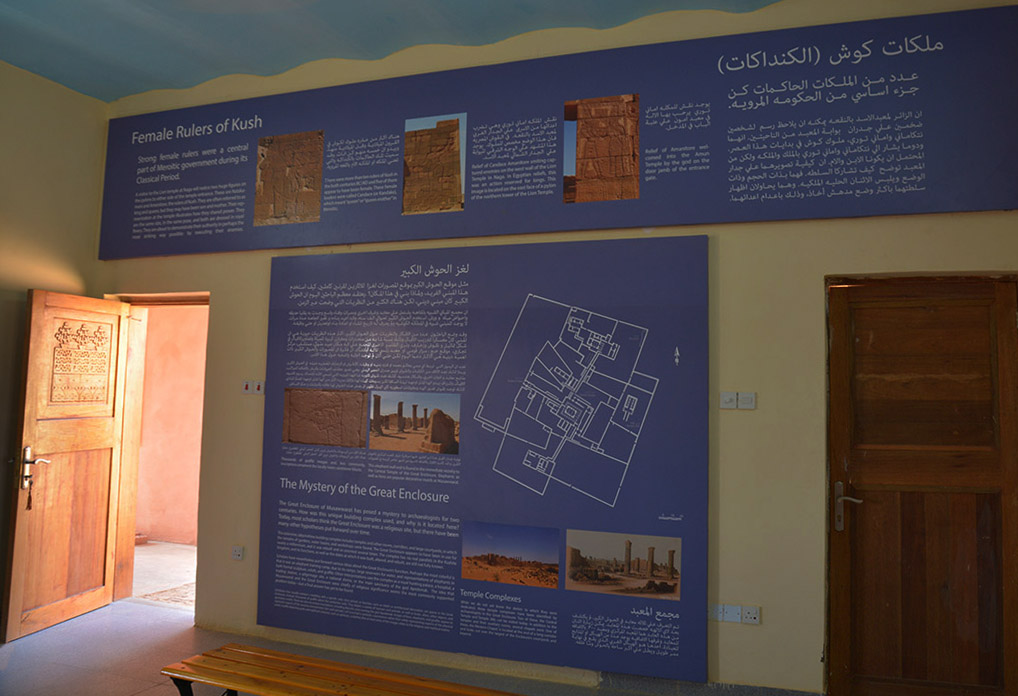The Visitor Center at the Archaeological Sites of the Island of Meroe is opening for guests. The Visitor Center is the gateway to the archaeological heritage of the heartland of the Kingdom of Kush. The themes explored across the Visitor Center panels reveal the ancient history of Sudan, archaeological discoveries at notable Sudanese sites, and other aspects of Sudanese culture, history, and economy.
In what follows, we will give you a short virtual tour of two of the Center’s rooms.
Panels from the room dedicated to the archaeological site of Meroe
Panel discussing the political implications surrounding the relocation of the Kushite Necropolis.
The necropolis was relocated from Napata to Meroe at the beginning of the third century BCE. Before Meroe became the site of the royal necropolis, the pyramids of Kushite rulers were constructed at El-Kurru and Nuri. These sites are located several hundreds of kilometers north of Meroe, near Napata. The royal cemetery’s move has been interpreted as the final and most visible step during a gradual shift in political and religious power from the Napatan region to Meroe. This marked the end of the Napatan period and the beginning of the Meroitic period.
Panels exploring archaeological research regarding the Royal City, iron production at Meroe, and other aspects of the Meroitic economy.
The Royal City of Meroe was the Meroitic Empire’s political and religious core. The remains of several royal palaces, spacious residences for important officials, and sacred buildings for the Meroitic gods are located inside and outside a massive enclosure wall.
The Iron Working panel describes recent research at Meroe indicating that the site was mass-producing iron throughout the Napatan, Meroitic, and Post-Meroitic periods, making it one of Africa’s longest continuously operating iron production centers.
The Other Aspects of Meroitic Economy panel reveals economic activities that were not related to iron production which were being undertaken at Meroe. This panel focuses on international trade and agriculture.
Panel showcasing the various types of pyramids constructed across Sudan.
Several types of pyramids were constructed over the centuries in El-Kurru, Nuri, Jebel Barkal, and Meroe. Kings and queens, and some members of the social stratum just below royalty (such as generals and wealthy traders), were buried in underground tombs, typically with three chambers. Pyramids were built on top of these tombs and were often bounded by walls and a small chapel.
Panel detailing aspects of Meroitic society and urban life.
Beginning in the third century BCE and lasting until the mid-fourth century CE, the city of Meroe became a capital town of the Kushite kingdom. Located in a strategic position, which allowed easy access to trade routes leading to the Red Sea, to Ethiopia, and further south into sub-Saharan Africa, Meroe’s importance predated the third century BCE. Meroe was a settlement for the royal family, the court, an administrative and religious center, and a dwelling place for the general public.
Panels from the room dedicated to Musawwarat and Naga
Panel introducing the site of Musawwarat es-Sufra.
The ancient monuments at Musawwarat es-Sufra attest to a singular sacral site. Its main structures, such as the Great Enclosure, the Lion Temple and the Great Hafir, were built during the Napatan and (Early) Meroitic periods of the Kingdom of Kush, between the sixth and second centuries BCE.
Panels focusing on female rulers of Kush and on the Great Enclosure at Musawwarat.
The Female Rulers of Kush panel reveals that female rulers were a central part of Meroitic government during its Classical Period.
The Mystery of the Great Enclosure panel focuses on a monumental structure uncovered at Musawwarat, whose function has been difficult to ascertain. Today, most scholars think the Great Enclosure was a religious site, but there have been many other hypotheses put forward over time. Perhaps the most imaginative interpretation, the notion that the structure was an elephant training camp has since been abandoned. Scholars arguing this position have pointed to the ramps, the large reservoirs for water, and the ubiquity of representations of elephants in both formal sculpture, reliefs, and graffiti. Other interpretations saw the complex as a royal hunting palace, a hospital, a trading station, a pilgrimage site, a national shrine, or the main sanctuary of the god Apedemak. Despite the fact that a consensus has not been achieved, the idea that Musawwarat and the Great Enclosure were chiefly of religious significance seems the most commonly supported position today.
These panels discuss the geographic and political position of Musawwarat and Naga, introduce the god Apedemak, and communicate key aspects relating to Kushite art and architecture, as revealed by structures from the site of Naga.
The Apedemak: A New Supreme Deity panel discusses the rise in importance of this autochthonous lion-headed god. For centuries, the major temples of Kush had been built to honor the gods of the Egyptian pantheon, such as the supreme god Amun, who was closely linked to royal legitimation. With the shift of the Kushite kingdom’s political center to the south, however, the cults of the indigenous gods gained prominence. Paramount among these local gods was the lion-headed god Apedemak, whose first temple was constructed at Musawwarat.
The Beyond the Nile Valley panel reveals the political and geographic position of these two sites and discusses their similarities and differences. Beyond the Nile, Musawwarat es-Sufra and Naga are the two most prominent sites of the Island of Meroe. One interesting point of comparison between the two settlements involves the temples to the Kushite deity Apedemak. Musawwarat contains the earliest known temple of Apedemak, but the hieroglyphs at the temple tell us that the deity was lord of both Musawwarat and Naga.
The Naga’s Art and Architecture panel discusses the great variety of Meroitic art and architecture that is very well preserved in this nigh pristine landscape. A typical feature of the architecture of this site is the cultural and artistic synergy between local and external stylistic elements.
Panel discussing the area’s strategic position.
Because of the advantages conferred by its geographic position, the Island of Meroe was able to participate in both Nile riverine trade and terrestrial trade. This area linked the northeastern African interior with the Red Sea and the Mediterranean with sub-Saharan Africa. The Kushite trade routes to the Red Sea also connected them to the Near East. Kush therefore occupied a unique place—economically, geographically, and culturally—in the ancient world.
What to look out for…
We are excited to announce that the Meroe Visitor Center will soon be featured in a major travel publication. Stay tuned for more details!









